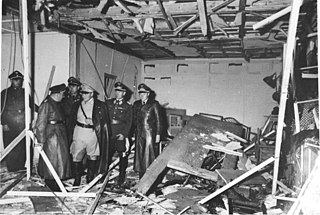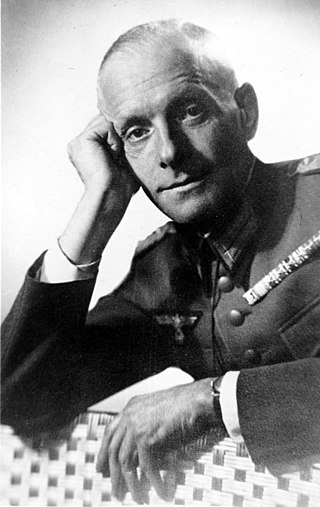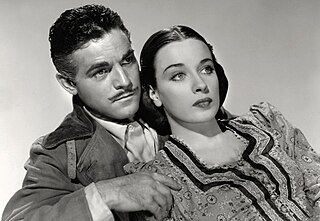
Reinhard Tristan Eugen Heydrich was a high-ranking German SS and police official during the Nazi era and a principal architect of the Holocaust.
Sicherheitsdienst, full title Sicherheitsdienst des Reichsführers-SS, or SD, was the intelligence agency of the SS and the Nazi Party in Nazi Germany. Established in 1931, the SD was the first Nazi intelligence organization and the Gestapo was considered its sister organization through the integration of SS members and operational procedures. The SD was administered as an independent SS office between 1933 and 1939. That year, the SD was transferred over to the Reich Security Main Office, as one of its seven departments. Its first director, Reinhard Heydrich, intended for the SD to bring every single individual within the Third Reich's reach under "continuous supervision".

The Lidice massacre was the complete destruction of the village of Lidice in the Protectorate of Bohemia and Moravia, which is now a part of the Czech Republic, in June 1942 on orders from Nazi leader Adolf Hitler and acting Reichsprotektor Kurt Daluege, successor to Reinhard Heydrich. It has gained historical attention as one of the most documented instances of German war crimes during the Second World War, particularly given the deliberate killing of children.

The 20 July plot was a failed attempt to assassinate Adolf Hitler, the chancellor and leader of Nazi Germany, and subsequently to overthrow the Nazi regime on 20 July 1944. The plotters were part of the German resistance, mainly composed of Wehrmacht officers. The leader of the conspiracy, Claus von Stauffenberg, planned to kill Hitler by detonating an explosive hidden in a briefcase. However, due to the location of the bomb at the time of detonation, the blast only dealt Hitler minor injuries. The planners' subsequent coup attempt also failed and resulted in a purge of the Wehrmacht.

The Berghof was Adolf Hitler's holiday home in the Obersalzberg of the Bavarian Alps near Berchtesgaden, Bavaria, Germany. Other than the Wolfsschanze, his headquarters in East Prussia for the invasion of the Soviet Union, he spent more time here than anywhere else during his time as the Führer of Nazi Germany. It was also one of the most widely known of his headquarters, which were located throughout Europe.

Reinhard Heydrich, the commander of the German Reich Security Main Office (RSHA), the acting governor of the Protectorate of Bohemia and Moravia and a principal architect of the Holocaust, was assassinated during the Second World War in a coordinated operation by the Czechoslovak resistance. The assassination attempt, code-named Operation Anthropoid, was carried out by resistance operatives Jozef Gabčík and Jan Kubiš on 27 May 1942. Heydrich was wounded in the attack and died of his injuries on 4 June.

Arthur Nebe was a German SS functionary who held key positions in the security and police apparatus of Nazi Germany and was, from 1941, a major perpetrator of the Holocaust.

Jan Kubiš was a Czech soldier, one of a team of Czechoslovak British-trained paratroopers sent to eliminate acting Reichsprotektor (Realm-Protector) of Bohemia and Moravia, SS-Obergruppenführer Reinhard Heydrich, in 1942 as part of Operation Anthropoid. During the assassination attempt, Kubiš threw a makeshift grenade that mortally wounded Heydrich.

Jozef Gabčík was a Slovak soldier in the Czechoslovak Army involved in the Operation Anthropoid, the assassination of acting Reichsprotektor (Realm-Protector) of Protectorate of Bohemia and Moravia, SS Obergruppenführer Reinhard Heydrich.

Ležáky, in the Miřetice municipality, was a village in Czechoslovakia. During the German occupation of Czechoslovakia, it was razed by Nazi forces as reprisal for Reich Protector Reinhard Heydrich's assassination in late spring 1942.
Operation Spark was the code name for the planned assassination of Nazi dictator Adolf Hitler by the anti-Nazi conspiracy of German Army officers and political conservatives, known as the Schwarze Kapelle during World War II. The name was coined by Major General Henning von Tresckow in 1941. He believed that because of Hitler's many successes up to that time, his personal charisma, and the oath of personal loyalty to him sworn by all German army officers, it would be impossible to overthrow Hitler and the Nazis with Hitler still alive. Hitler's death, however, would be a "spark"—a signal that it was time to launch an internal coup d'état to overthrow the Nazi regime and end the war.

Operation Daybreak is a 1975 war film based on the true story of Operation Anthropoid, the assassination of SS general Reinhard Heydrich in Prague. Starring Anthony Andrews, Timothy Bottoms and Martin Shaw, the film was directed by Lewis Gilbert and shot mostly on location in Prague. It is adapted from the book Seven Men at Daybreak by Alan Burgess.

Karel Čurda was a Czech Nazi collaborator during World War II.

The Oster Conspiracy of 1938 was a proposed plan to overthrow German Führer Adolf Hitler and the Nazi regime if Germany went to war with Czechoslovakia over the Sudetenland. It was led by Generalmajor Hans Oster, deputy head of the Abwehr and other high-ranking conservatives within the Wehrmacht who opposed the regime for behavior that was threatening to bring Germany into a war that they believed it was not ready to fight. They planned to overthrow Hitler and the Nazi regime through a storming of the Reich Chancellery by forces loyal to the plot to take control of the government, who would either arrest or assassinate Hitler, and restore the Monarchy under Prince Wilhelm of Prussia, the grandson of Wilhelm II.

Hitler's Madman is a 1943 World War II drama directed by Douglas Sirk. It is a fictionalized account of the 1942 assassination of Nazi official Reinhard Heydrich and the resulting Lidice massacre, which the Germans committed as revenge. The film stars Patricia Morison and Alan Curtis and features John Carradine as Reinhard Heydrich. Sirk intended the film to function more as a documentary, but after Louis B. Mayer acquired the film in February 1943, he required reshoots to increase the drama. According to TCM, “Added material included Heydrich's deathbed scene with "Himmler" and university scenes featuring M-G-M starlets, including Ava Gardner.”

Adolf Hitler, the dictator of Nazi Germany, initiated World War II in Europe with the invasion of Poland in September 1939 and was central to the Holocaust. He was hated by his persecuted enemies and even by some of his own countrymen. Although attempts were made to assassinate him, none were successful. Hitler had numerous bodyguard units over the years which provided security.

Anthropoid is a 2016 war film directed by Sean Ellis and starring Cillian Murphy, Jamie Dornan, Charlotte Le Bon, Anna Geislerová, Harry Lloyd, Toby Jones and Marcin Dorocinski, It was written by Ellis and Anthony Frewin. It depicts Operation Anthropoid, the assassination of Reinhard Heydrich by exiled Czechoslovak soldiers Jozef Gabčík and Jan Kubiš in World War II. It was released on 12 August 2016 in the United States and 9 September 2016 in the United Kingdom.

The Man with the Iron Heart is a 2017 biographical action-thriller film directed by Cédric Jimenez and written by David Farr, Audrey Diwan, and Jimenez. An English-language French-Belgian production, it is based on French writer Laurent Binet's 2010 novel HHhH, and focuses on Operation Anthropoid, the assassination of Nazi leader Reinhard Heydrich in Prague during World War II.

Helmuth Groscurth was a German staff and Abwehr officer in the Wehrmacht and a member of the German resistance. As an intelligence officer he was an early proponent of the Brandenburgers, commanded unconventional warfare operations in the Sudetenland, and was an active conspirator against Hitler's agenda. He was later reassigned to the regular army following his criticism of war crimes committed by German forces in Poland. After commanding an infantry battalion in the invasion of France he assumed a variety of staff roles. He was involved in the events of the Bila Tserkva massacre where he attempted to avert the killing of Jewish children.

The Berchtesgaden Chancellery Branch office in Bischofswiesener district Stanggaß was built between 1937 and 1945 after plans by Alois Degano as the second seat of government of Nazi Germany for the time of Adolf Hitler's presence on nearby Obersalzberg.


















